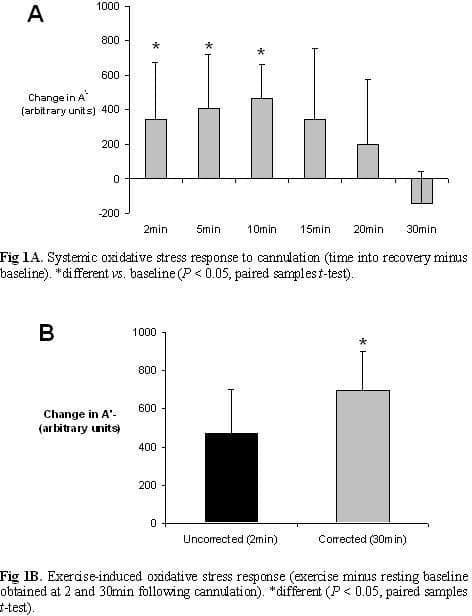Recognition of free radicals as redox signalling molecules, implicit in the regulation of cellular oxygen homeostasis during physical exercise justifies continued interest into their mechanisms of generation in-vivo. Hypoxia, re-oxygenation or exercises, independently have a profound influence on the level of free radical generation in human beings(1, 2, 3). The present study was designed to test the hypothesis that the physiological trauma associated with venous cannulation may artefactually stimulate systemic free radical formation in the acute phase that if not accounted for may under-estimate the oxidative stress response to exercise. Six males aged 34 ± 2 years (mean ± SD) participated in Phase I of the study. A resting venous blood sample was obtained from the cephalic vein of the non-dominant forearm using a cuff inflated for 60s to 20mmHg below the measured systolic pressure to avoid ischaemia-reperfusion. Samples were collected immediately following venous cannulation (0min) and at 2, 5, 10, 15, 20 and 30min into recovery. Twelve separate males aged 23 ± 5 years volunteered for Phase II. Samples were obtained at rest after 2 and 30min following venous cannulation and immediately after a cycling test to volitional exhaustion. Plasma was extracted and injected into a high-sensitivity multi-bore aqueous cell prior to X-band electron paramagnetic resonance spectroscopy for direct detection of the ascorbate radical. Venous cannulation increased ascorbate free radical which remained elevated until 30min into recovery (Fig 1A). The exercise-induced increase in ascorbate radical was subsequently shown to be 48% greater when the 30min as opposed to the 2min post-cannulation resting baseline (1754 ± 361 vs. 1979 ± 375 AU, P < 0.05) was incorporated into the calculation (Fig 1B). These findings demonstrate that venous cannulation per se stimulates the systemic formation of free radicals which peak at 10min and require approximately 30min to normalise. If this baseline artefact is not taken into account, the “real” magnitude of the exercise-induced oxidative stress response will be under-estimated.
University of Cambridge (2008) Proc Physiol Soc 11, PC28
Poster Communications: Venous cannulation triggers systemic free radical formation; interpretive implications for exercise-induced oxidative stress
M. Gutowski1, L. Fall1, D. Bailey1
1. Neurovascular Research Unit, University of Glamorgan, Treforest, United Kingdom.
View other abstracts by:
Where applicable, experiments conform with Society ethical requirements.

